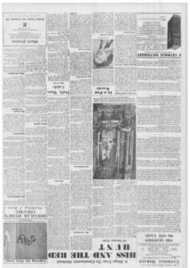Page 2, 15th May 1953
Page 2

Report an error
Noticed an error on this page?If you've noticed an error in this article please click here to report it.
Tags
Share
Related articles
The Church And Art
Worship
Letters To The Editor
'art As A Means .
ART AND WORSHIP
First Aim of Art
S1R,-Every artist will certainly be grateful to Fr. J. D. Crichton for having raised the problem of so-called -modern art" in churches, for elucidating many important points and, especially, for the wise conclusion of his article. The problem, however, is so important and the situation so grave that, I hope, this is only the beginning of a serious discussion on this subject in THE CATHOLIC HERALD. As for myself, although I agree with Fr. Crichton in several conclusive points, I have to challenge his basic statement that the first and only purpose of liturgical art is to "help ordinary Christians to pray." This, I firmly believe, is a fundamental mistake.
The whole history of the Church and art shows quite clearly that the first and most important purpose of liturgical art, as indeed of any art and beauty, is to give praise to God. Art is not a means to stimulate worship, it is worship itself in which the worshipper is not the artist alone but, first of all, the society which emanate and employ the artist. If that were not true, the wonderful and enormous cathedrals, the tremendous frescoes, the countless paintings, statues and mosaics, the majority of which millions of ordinary Christians were never, and never will be, able to apprehend, would not have been done.
The "practical purpose," however important, is therefore a secondary one. A serious and conscientious artist cannot create in deliberate conformity with the taste of "ordinary folk." That would impose on him such limitations that he would not be able to do his best and "only the best is good for God."
The fact that many artists are abusing the "artist's liberty" and creating "monstrosities" is another question and it should not curb the wings of creative artists so that they could please the people.
The great words of the Psalmist repeated every day everywhere by every Catholic priest saying the Mass "Domine. diIexi decor e m domus Tuae ..." should he taken as a motto by every artist working for, and every priest in charge of, a House of God.
The real understanding of these words would certainly help the artist and the people to fill up the gap which is dividing them.
Adam Kossowski. 38 Redcliffe Road, London, S.W.10.
Cultural Art Centre?
SIR, THE CATHOLIC HERALD
article, "New Move to Cut Out Repository Art," is interesting. There is need in this country for an officially sponsored movement such as that in Spain on which you quote the comments of Fr. Diaz. Freelance and commercially derived centres have serious disadvantages. A Catholic cultural centre giving exhibitions, lectures. etce could be most successful in the hands of trained nuns such as those who organised the Catholic P.O.W. and Missing Bureau during the second World War.
Purses are lean; shops often reluctant to risk stocking work higher in price than repository art. Although there is a small and vocal public that demands better design and craftsmanship it is not understood that an artist's work in fine materials must needs cost more to produce than a factory-made object into which have been put the minimum of thought and the cheapest and poorest materials.
There are in England "pleiades of artists formed by faith," but we do not "give them the means to live and work in the service of truth." I write f r o m experience. Manufacturers raise workers' wages and price of paints, etc.. but the middle man resists the artist's need.for a corresponding rise in payment for work which may have cost three times what it would have done a short time ago to produce. This oppresses the artist; and depresses the level of c,1total inspiration in homes, churches and religious houses.
Catholics today are encouraged to substitute tinsel-tawdry for pure gold in the service of the altar; little informed guidance is given about pictures, crucifixes, statues. 'Yet, well chosen, these could be true sacramentals-remembrancers and aids to Christian living. Children spontaneously recognise, acclaim and venerate the inspiration in real Catholic art.
Where a thing is valued it is worth some sacrifice to obtain it. Only the superficially minded and the shallow prefer expressionless, stereo-typed, mass-produced objects to such an outcome of thought as can lift eves to the mountain of God and the little heaven of Nazareth. It is a good thing that a Spanish priest has said something of this sort, and that the Supreme Sacred College of the Holy Office has given a lead.
"A Catholic Artist."
blog comments powered by Disqus









